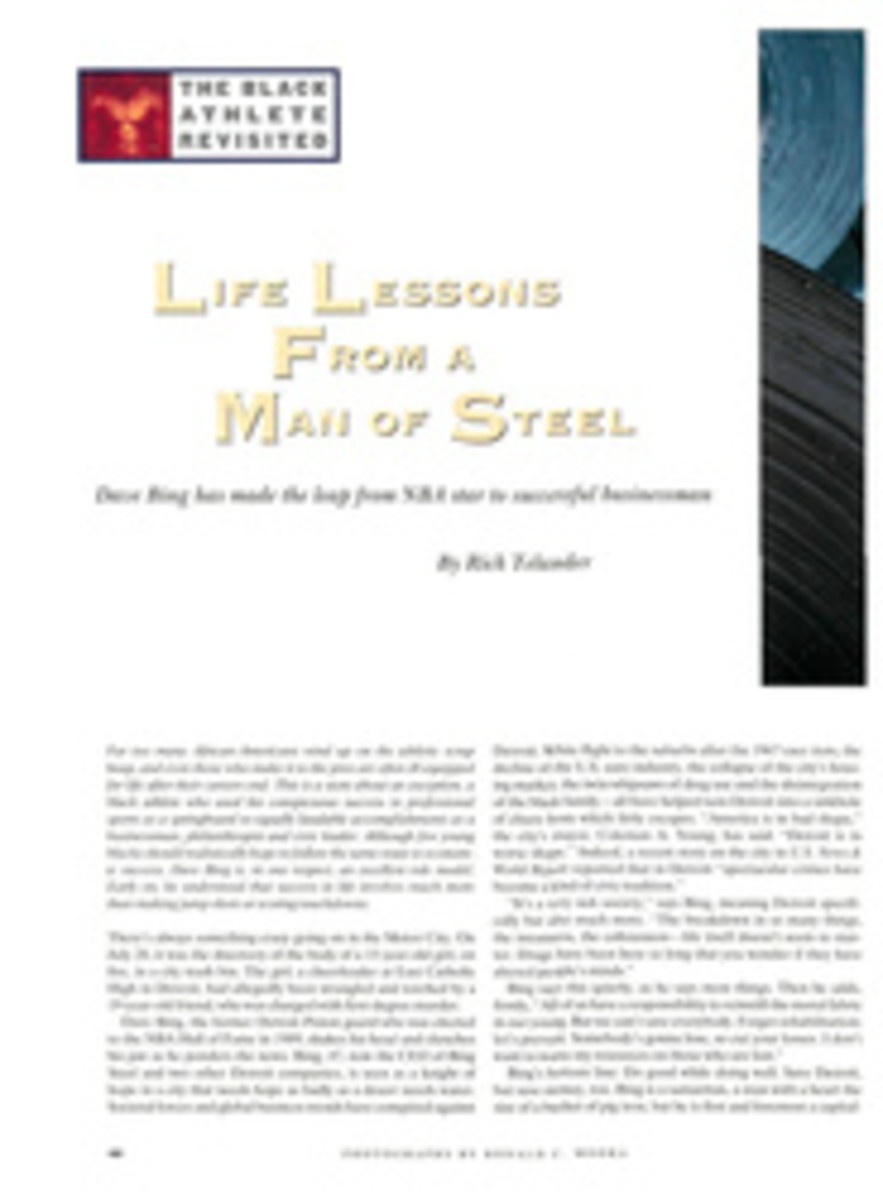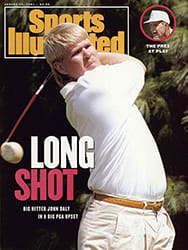
OVER DRIVE
You don't have to believe what happened at Crooked Stick last week. You can accept as fiction the news that an unknown Arkansas pro named John Daly bludgeoned a golf course into submission on his way to a three-shot victory in the 1991 PGA Championship. You can roll your eyes when you hear eyewitnesses swear that the 25-year-old Tour rookie is golf's next superstar, and never mind that he never won a tournament in three years at the University of Arkansas or that his 300-plus-yard drives rarely found the fairways until last week.
You don't have to believe what happened because Daly himself can't believe it. "This is like a miracle," he said Sunday after holing an almost ceremonial four-foot par putt on the final hole. "It just doesn't happen that often."
No, it's not often that the ninth alternate is admitted to a major championship and then embarrasses the world's most seasoned golfers. Daly had to drive all night from his home in Memphis to get to Carmel, Ind., in time for the first round. He still wasn't sure he was playing until Thursday morning, when he replaced Nick Price, who stayed home to await the birth of his first child. (It's a boy!) But Daly went straight out onto a course he had never seen and shot 69. That got him a mention in the "Tournament Notes."
His play on Friday through Sunday should get him into Ripley's Believe It or Not, right next to the improbable Jack Fleck, who beat Ben Hogan in a playoff to win the 1955 U.S. Open. Daly took the lead on Friday morning and never relinquished it, finishing with 21 birdies, one eagle and a 12-under-par 276. He led the field by as many as five shots, and he made grown men and women babble over his astonishing length off the tee.
"The first two or three drives he hit, I wasn't able to see," said runner-up Bruce Lietzke, "because the ball came off the club face faster than I was used to."
Look for a run on Cobra drivers with titanium shafts and heads made of Kevlar, a material used in bulletproof vests. "A friend of mine took a .44 Magnum and blew the head off [the driver]," said Daly, "so they're not bulletproof."
Actually, the source of Daly's power is a stretch-till-you-tear body turn and one not-so-subtle thought in midswing: Kill. At the Honda Classic in March, Daly socked his drive at the 15th so far that he almost hit Greg Norman, who was playing in the group ahead of him. Last week, Daly's enormous club-head speed enabled him to fly tee shots over fairway bunkers and take huge shortcuts on dogleg holes. Where other pros were hitting three-irons into greens, he was hitting seven- and eight-irons. Even his blunders were prodigious: He double-bogeyed the 8th hole on Saturday by hitting a 143-yard sand wedge shot over the green and into the lake.
The chief victim of Daly's onslaught was a Crooked Stick course that architect Pete Dye had lengthened to 7,289 yards, the second longest in PGA history. After three practice rounds, Jack Nicklaus said it was the most difficult course he had ever played. And two-time U.S. Open champion Curtis Strange, after shooting 81 on Thursday, said something that no one could print and stormed out of Carmel without playing the second round.
As counterpoint to these shrill observations, numerous players shot bass-clef scores. Kenny Knox, a banjo-hitting PGA Tour stalwart, employed a straight-faced driver to squeeze some extra roll from his drives and wound up sharing the first-round lead with Masters champ Ian Woosnam at 67. Thirty-seven others broke par on Thursday, and 31 wound up at par or better for the tournament.
It was sweet music to Dye, who strives for the paradoxical in his designs. Crooked Stick gave up 19 eagles in four rounds, more than one would expect, but double-bogeys were as common as mushrooms in May. The finishing holes, in particular, proved treacherous. On Friday, Craig Stadler and Nick Faldo had double-bogeys at 16, and Gary Hallberg filled the lake at 18 with golf balls and made a 12. Nicklaus and Ray Floyd both doubled 18 on Thursday and Friday.
That's what made Daly's bid so compelling. From the moment his name went on the leader board, the crowds at Crooked Stick thought he was a sand castle and the golf course a rising tide. His nicknames—Macho Man, Wild Thing and Killer—presaged a crack-up, as did his PGA Tour rankings: first in driving distance, 185th in driving accuracy. Daly himself characterized his position as second-round leader as a fluke, saying, "I'll remember this day the rest of my life."
But it was sunny Saturday that was most memorable. Daly went into a three-hole stretch on the front side as a feisty rookie. He came out as Paul Bunyan in spikes. He birdied the 456-yard 4th with a big drive and a skyscraper-high eight-iron that dropped a foot from the hole. He came within 10 yards of reaching the green in two on the 609-yard 5th, despite pushing his drive way right into trampled rough. He almost holed the chip for eagle but settled for a tap-in birdie. Then on the sixth, a picturesque 199-yard par-3, he flew a five-iron over the water to a sucker pin placement and sank a downhill 12-footer for his third straight birdie. Daly's growing legion of supporters, lining each hole like a parade route, roared and gave him ovations at every green.
"He had an Arnold Palmer-type reception out there," said Lietzke, who was paired with Daly on Saturday. "Especially on some of those iron shots that were up there a minute and a half and came down by the hole."
Daly's back nine was given rhapsodic treatment by the CBS cameras and announcers. Viewers were told that Daly's club head was too fast to be captured by the slow-motion cameras (an exaggeration) and that he had once broken a golf ball by hitting it. (Not true, according to Daly. "It was just a Titleist that had a cut in it, and you could hear the winding buzz as it went through the air.") When asked to comment on the rookie's swing, Nicklaus watched a slow-mo of Daly driving and said, "Good gracious, what a coil, what an unleashing of power. I don't know who he reminds me of. I haven't seen anybody who hit the ball that far."
Writers began calling their newspapers to ask, "How do you spell Sidd Finch?" And then came the heart-stopper. After birdieing the 18th on Saturday for a three-shot lead, Daly learned in the scorer's trailer that he might have inadvertently violated a rule while putting for eagle on the 11th green.
The rule—affectionately known as "8-2b"—states that neither the player nor his caddie may touch the putting surface along the line of the putt to assist in aiming. The replays clearly showed that caddie Jeff (Squeaky) Medlen, a Tour veteran who picked up Daly's bag when Price dropped out, had momentarily rested the end of the flagstick behind the hole as Daly eyed the line. This violation required a two-stroke penalty in the eyes of the three need-a-life armchair officials who had phoned in their rulings.
Calmer heads prevailed. In a decision with Pine Tar Game overtones, the rules committee honored the spirit rather than the letter of the law and ruled that there was no violation—the pin had touched down on the low side of the hole, not on the side on which Daly was aiming. Thus, by 10 inches or so, did the PGA of America avoid what would have been the most unpopular rules decision since the Roberto de Vicenzo scorecard fiasco at the 1968 Masters.
That gave Daly three shots to work with on Sunday, and they were more than enough. A bogey on the 1st hole, the easiest par 4 on the course, and a double-bogey on the vicious 17th were his only miscues. Birdies on two, five, 13 and 15 kept the field at bay—only Lietzke and Knox were persistent pursuers—and the crowd yelping. As he walked up the 18th fairway after hitting an eight-iron to the middle of the green, Daly pumped his right arm to crank up the already deafening ovation from the bleachers.
It was a vindication of sorts for Daly, who taught himself to play on a nine-hole course in Dardanelle, Ark. (pop. 3,621), using balls he had fished out of a pond. He is blunt in his assessment of teaching pros ("They're always trying to change your grip") and college golf ("Too much brownnosing going on"), and he doesn't deny that he has had club-breaking fits in the face of adversity. However, none of that was in evidence on Sunday.
"I can tell you one thing, I've done this my way," said Daly, whose 1991 earnings of $166,590 were dwarfed by the $230,000 winner's check. "I don't have anybody to blame for this win but me, and I love it."
So the question asked on Friday and Saturday—"Who is he?"—now becomes "Who will he be?" Pro golf has had its one-week miracles but never one like Daly. Perhaps something fundamental happened to him at Crooked Stick, something that transmogrified the wild rookie who this year had missed 11 cuts in 24 events going into the PGA. Maybe he is no longer the player who shot two 83s at the Memorial Tournament in May. But everyone in golf must wonder, as does Daly, What comes next?
Said Lietzke, "I'm leaning toward the kid being real."
PHOTO
JACQUELINE DUVOISIN
Daly, rookie touring pro, uncoiled with Such force that he briefly made his own crooked stick.
PHOTO
JACQUELINE DUVOISIN
When Daly's power stroke got him into trouble, he showed he had superb touch as well.
PHOTO
JACQUELINE DUVOISIN
Daly's "miracle" run from ninth alternate to PGA champ drew a rousing standing ovation.

